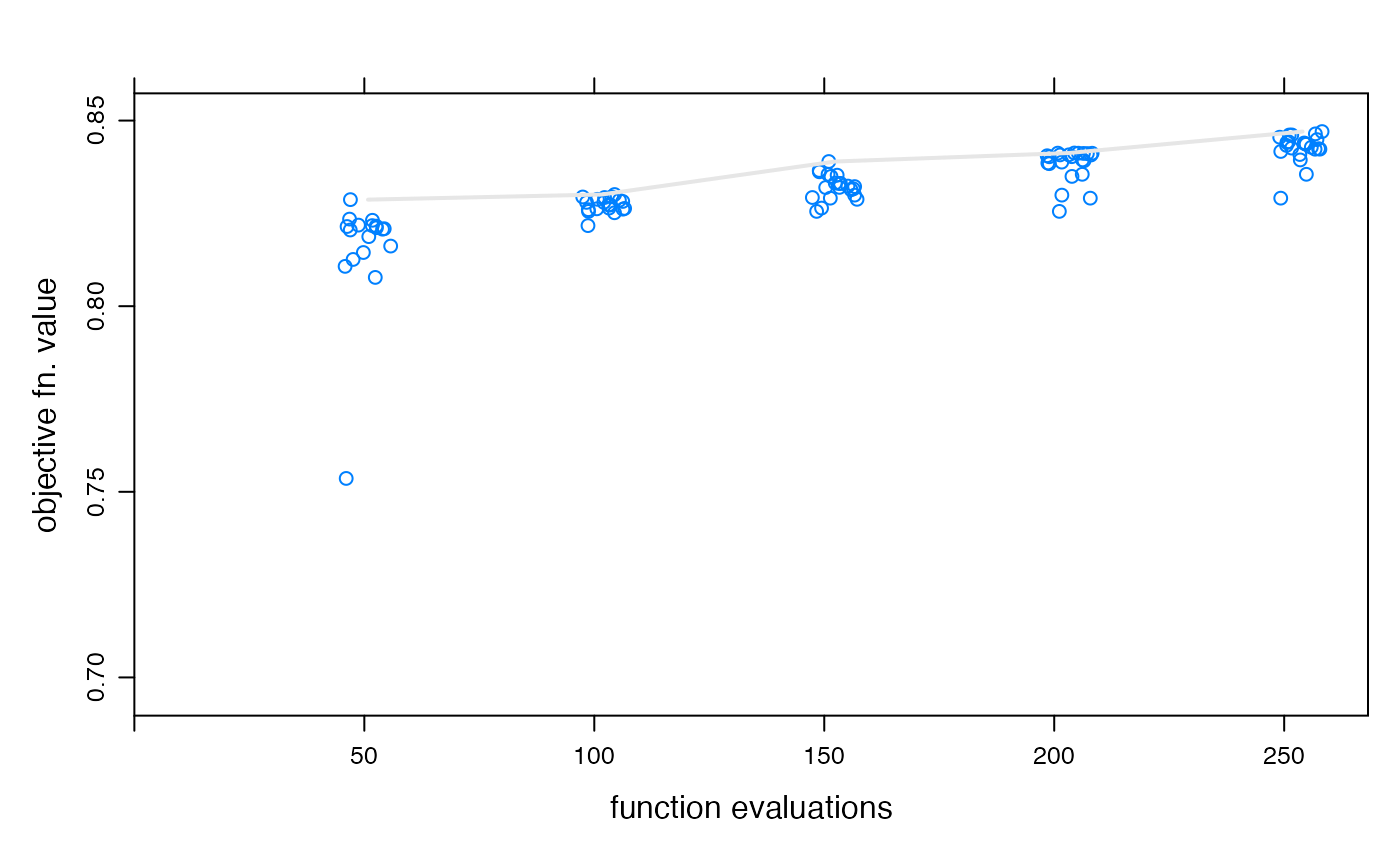Fit a hydromad model using the SCE (Shuffled Complex Evolution) algorithm.
Source:R/fitBySCE.R
fitBySCE.RdFit a hydromad model using the SCE (Shuffled Complex Evolution) algorithm.
fitBySCE(
MODEL,
objective = hydromad.getOption("objective"),
control = hydromad.getOption("sce.control"),
vcov = FALSE
)Arguments
- MODEL
a model specification created by
hydromad. It should not be fully specified, i.e one or more parameters should be defined by ranges of values rather than exact values.- objective
objective function to maximise, given as a
function(Q, X, ...). SeeobjFunVal.- control
settings for the SCE algorithm. See
SCEoptim. Note that unlike SCEoptim, the objective function is maximised (fnscale=-1) by default.- vcov
if
vcov = TRUE, the parameter variance-covariance matrix will be estimated from the final population. It can be extract usingvcov.
Value
the best model from those sampled, according to the given
objective function. Also, these extra elements are inserted:
- fit.result
the result from
SCEoptim.- objective
the
objectivefunction used.- funevals
total number of evaluations of the model simulation function.
- timing
timing vector as returned by
system.time.
Examples
data(Cotter)
x <- Cotter[1:1000]
## IHACRES CWI model with power law unit hydrograph
modx <- hydromad(x, sma = "cwi", routing = "powuh")
modx
#>
#> Hydromad model with "cwi" SMA and "powuh" routing:
#> Start = 1966-05-01, End = 1969-01-24
#>
#> SMA Parameters:
#> lower upper
#> tw 0 100
#> f 0 8
#> scale NA NA
#> l 0 0 (==)
#> p 1 1 (==)
#> t_ref 20 20 (==)
#> Routing Parameters:
#> lower upper
#> a 0.01 60
#> b 0.50 3
#> c 0.50 2
## run with cut-down settings (for a speedy example only!)
foo <- fitBySCE(modx, control = list(maxit = 5, ncomplex = 2))
#> Warning: Maximum number of function evaluations or iterations reached.
summary(foo)
#>
#> Call:
#> hydromad(DATA = x, sma = "cwi", routing = "powuh", a = 4.96111,
#> b = 1.0574, c = 1.43395, tw = 97.6414, f = 6.6972, scale = 0.00135911)
#>
#> Time steps: 900 (0 missing).
#> Runoff ratio (Q/P): (0.7028 / 2.285) = 0.3075
#> rel bias: -1.504e-16
#> r squared: 0.7374
#> r sq sqrt: 0.8245
#> r sq log: 0.8139
#>
#> For definitions see ?hydromad.stats
#>
## return value from SCE:
str(foo$fit.result)
#> List of 11
#> $ call : language SCEoptim(FUN = do_sce, par = initpars, lower = lower, upper = upper, control = control)
#> $ control :List of 13
#> ..$ ncomplex : num 2
#> ..$ cce.iter : logi NA
#> ..$ fnscale : num -1
#> ..$ elitism : num 1
#> ..$ initsample: chr "latin"
#> ..$ reltol : num 1e-05
#> ..$ tolsteps : num 7
#> ..$ maxit : num 5
#> ..$ maxeval : num Inf
#> ..$ maxtime : num Inf
#> ..$ returnpop : logi FALSE
#> ..$ trace : num 0
#> ..$ REPORT : num 1
#> $ par : Named num [1:5] 4.96 1.06 1.43 97.64 6.7
#> ..- attr(*, "names")= chr [1:5] "a" "b" "c" "tw" ...
#> $ value : num -0.847
#> $ convergence: num 1
#> $ message : chr "Maximum number of function evaluations or iterations reached."
#> $ counts : num 254
#> $ iterations : num 5
#> $ time : num 6.49
#> $ POP.FIT.ALL: num [1:5, 1:22] -0.829 -0.83 -0.839 -0.841 -0.847 ...
#> $ BESTMEM.ALL: num [1:5, 1:5] 8.6 9.3 3.53 1.73 4.96 ...
#> ..- attr(*, "dimnames")=List of 2
#> .. ..$ : NULL
#> .. ..$ : chr [1:5] "a" "b" "c" "tw" ...
#> - attr(*, "class")= chr [1:2] "SCEoptim" "list"
## plot objective function value convergence over time
xyplot(optimtrace(foo, raw = TRUE),
screens = 1, type = "p",
jitter.x = TRUE, ylim = c(0.7, NA), xlim = c(0, NA),
xlab = "function evaluations", ylab = "objective fn. value"
) +
latticeExtra::layer(panel.average(..., horiz = FALSE, fun = max, lwd = 2))
